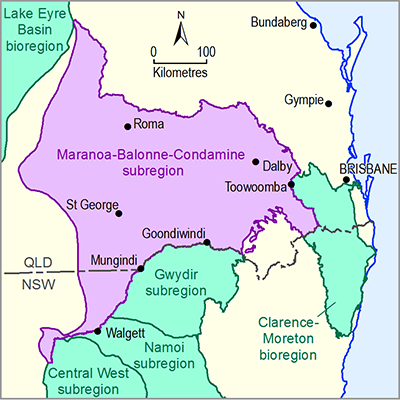Most of the assessment extent (72.2%) is dominated by human-modified landscapes used for agricultural production, forestry, mining and urban development (Table 8). This landscape group represents the areas not included in the remnant vegetation mapping (Queensland Herbarium, Department of Science, Information Technology, Innovation and the Arts, Dataset 10) and is predominantly dryland areas that have been cleared or highly modified. As such, it is likely that important natural ecosystems are not represented in this landscape group.
The water dependency of this landscape group ranges from a heavy dependence on groundwater and surface water extracted from nearby aquifers and streams (e.g. intensive uses and production from irrigated agriculture and plantations), through to dryland cropping and grazing that are reliant on incident rainfall and local surface water runoff (e.g. production from dryland agriculture and plantations). Deeper-rooted vegetation, including remnant vegetation and plantations may tap into groundwater within certain landscapes. Intensive areas, such as townships and extractive industries, often have a strong reliance on groundwater and surface water via bores and river offtakes.
Much of the area in the vicinity of New Acland Coal Mine is classified as ‘Human-modified’, indicating the fragmented nature of this landscape. There are large areas classified as ‘Conservation and natural environments’, ‘Production from dryland agriculture and plantations’ and ‘Production from relatively natural environments’. There are smaller areas classified as ‘Intensive uses’ and ‘Production from irrigated agriculture and plantations’.
The western parts of the zone of potential hydrological change in the vicinity of The Range coal mine are predominantly human-modified landscapes, including ‘Production from relatively natural environments’ and smaller areas of ‘Production from dryland agriculture and plantations’. This landscape is drained by temporary upland streams that flow into Juandah Creek on the western edge, which leads to the Dawson River in the north. Small areas are classified as ‘Conservation and natural environments’, ‘Intensive uses’, ‘Production from irrigated agriculture and plantations’, ‘Production from relatively natural environments’ and ‘Water’.
Hydrological response variables identified for the ‘Human-modified’ landscape group are summarised in Table 18. Areas with a heavy dependence on groundwater and surface water (e.g. ‘Intensive uses’ and ‘Production from irrigated agriculture and plantations’) may be affected by groundwater drawdown. ‘Make good’ obligations apply for groundwater bores affected by CSG extraction under Queensland’s Water Act 2000, where water pressure is predicted to fall by more than 5 m for consolidated aquifers, such as sandstone, and 2 m for unconsolidated aquifers, such as sand.
Areas classified as ‘Water’ may include temporary water bodies or artificial dams that will be affected by changes to the magnitude and duration of high flows and frequency of flood pulses. Other landscape classes are not considered to be water dependent for this Assessment (Table 18).
Table 18 Ecological relevance of hydrological changes for landscape classes in the ‘Human-modified’ landscape group that are contained within the zone of potential hydrological change
GDE = groundwater-dependent ecosystem

Product Finalisation date
- 3.1 Overview
- 3.2 Methods
- 3.3 Potential hydrological changes
- 3.4 Impacts on and risks to landscape classes
- 3.4.1 Overview
- 3.4.2 Landscape classes that are unlikely to be impacted
- 3.4.3 'Floodplain or lowland riverine (including non-GAB GDEs)' landscape group
- 3.4.4 'GAB GDEs (riverine, springs, floodplain or non-floodplain)' landscape group
- 3.4.5 'Non-floodplain or upland riverine (including non-GAB GDEs)' landscape group
- 3.4.6 'Human-modified' landscape group
- References
- Datasets
- 3.5 Impacts on and risks to water-dependent assets
- 3.6 Commentary for coal resource developments that are not modelled
- 3.7 Conclusion
- Citation
- Acknowledgements
- Contributors to the Technical Programme
- About this technical product
